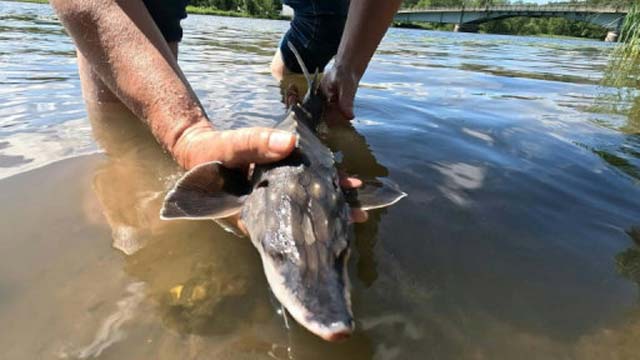
KUNGÄLV, Sweden, June 26, 2024 (BSS/AFP) - A century after it disappeared from Swedish waters, scientists in June embarked on a 10-year project to reintroduce the Atlantic sturgeon to a cleaned-up river in the west of the country.
In the opening act, 100 young sturgeons -- transferred from a farm in Germany -- were introduced into the waters of Gota alv.
"To be a person who has the possibility to re-introduce a species that has been extinct nationally, it's a gift," biologist Dan Calderon, who came up with the idea, told AFP.
"It's probably the best thing I've done," Calderon said.
Named "Storens aterkomst" (The return of the sturgeon), the project is led by the Swedish Anglers Association, which is working with several universities and Gothenburg's museum of natural history.
The species lived in the river until the late 19th century, but gradually disappeared due to overfishing and pollution.
Today, the river is much cleaner and conditions are again right for the sturgeon, which can measure over five metres (16 feet) and weigh more than 600 kilogrammes (270 pounds), according to the University of Gothenburg.
- 'Hopeful' -
"I also feel hopeful because this is really, really something good we are achieving here and this is a good start," Linnea Jagrud, the project leader, told AFP.
The effects of the reintroduction on the river ecosystem will be closely studied by researchers.
Sturgeons feed off the bottom of the river, which helps oxygenate sediment on the riverbed, therefore benefitting the small creatures that live there.
Large sturgeons can also serve as a host fish for other species such as the sea lamprey.
"One hundred does not make a population, but with the ongoing work we will build up a strong population and we will keep working with restoring the river and restoring the coastal area outside," Jagrud said.
Like salmon, the Atlantic sturgeon -- recognisable by its pointed nose and scaleless skin -- spends the first few years of its life in freshwater.
When it is large enough to tolerate salinity, it migrates to the sea in search of food and then returns to freshwater to spawn.
But it can take up to 10 years for the river dweller to reproduce.
It will therefore be necessary to gradually reintroduce sturgeons every year for a decade so that they can form a population capable of surviving without human assistance, Jagrud explained.
- European network -
In order to map the characteristics of the river and its suitability for the species, acoustic telemetric receivers have been placed underwater and some fish fitted with transmitters to track their movements.
"These kinds of receivers are all over Europe, in European waters and also abroad," Jagrud said.
"This means they're all connected in the same tracking network meaning if 'my' fish go to Portugal or Spain or France or UK, the European tracking network will report back to me and I will know, oh, my fish released in June 2024, oh, it reached Italy," she continued.
A crowd gathered on June 18 on the shores of the Gota alv to witness the historic return.
"This is a place where very many Nordic countries had their meetings and big feasts," said Miguel Odhner, mayor of the riverfront town Kungalv, explaining that royal guests often dined on the fish, which was caught in abundance at the time.
A sturgeon wriggles in the mayor's hands before being plunged into the water, to the applause of the crowd.
"Now it's time to pay back to nature," Odhner said.